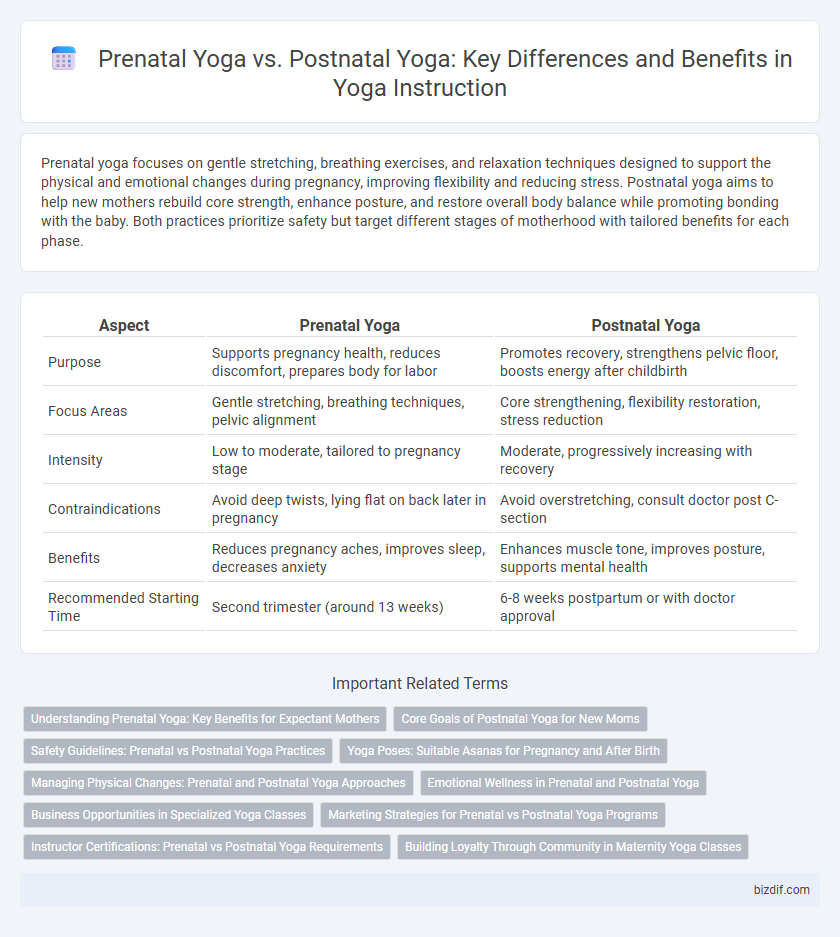Prenatal yoga focuses on gentle stretching, breathing exercises, and relaxation techniques designed to support the physical and emotional changes during pregnancy, improving flexibility and reducing stress. Postnatal yoga aims to help new mothers rebuild core strength, enhance posture, and restore overall body balance while promoting bonding with the baby. Both practices prioritize safety but target different stages of motherhood with tailored benefits for each phase.
Table of Comparison
| Aspect | Prenatal Yoga | Postnatal Yoga |
|---|---|---|
| Purpose | Supports pregnancy health, reduces discomfort, prepares body for labor | Promotes recovery, strengthens pelvic floor, boosts energy after childbirth |
| Focus Areas | Gentle stretching, breathing techniques, pelvic alignment | Core strengthening, flexibility restoration, stress reduction |
| Intensity | Low to moderate, tailored to pregnancy stage | Moderate, progressively increasing with recovery |
| Contraindications | Avoid deep twists, lying flat on back later in pregnancy | Avoid overstretching, consult doctor post C-section |
| Benefits | Reduces pregnancy aches, improves sleep, decreases anxiety | Enhances muscle tone, improves posture, supports mental health |
| Recommended Starting Time | Second trimester (around 13 weeks) | 6-8 weeks postpartum or with doctor approval |
Understanding Prenatal Yoga: Key Benefits for Expectant Mothers
Prenatal yoga enhances flexibility, reduces lower back pain, and promotes relaxation through breath control techniques tailored for expectant mothers. It supports optimal fetal positioning and helps manage common pregnancy discomforts such as swelling and fatigue. Practicing prenatal yoga regularly contributes to better sleep quality and prepares the body for labor and delivery.
Core Goals of Postnatal Yoga for New Moms
Postnatal yoga primarily focuses on restoring core strength, enhancing pelvic floor stability, and promoting overall recovery for new moms. It targets deep abdominal muscles weakened by pregnancy and supports hormonal balance to reduce postpartum stress. Emphasizing gentle movement and breathwork, postnatal yoga aids in regaining flexibility and boosting energy levels while nurturing emotional well-being.
Safety Guidelines: Prenatal vs Postnatal Yoga Practices
Prenatal yoga prioritizes gentle stretches, avoiding deep twists and intense poses to protect the developing fetus and accommodate the mother's changing body, emphasizing breathing techniques and pelvic floor strengthening. Postnatal yoga focuses on rebuilding core strength and improving posture while being cautious of abdominal separation (diastasis recti) and avoiding strenuous movements until cleared by a healthcare provider. Both practices stress listening to the body's signals and modifying poses to ensure safety and promote recovery during pregnancy and postpartum stages.
Yoga Poses: Suitable Asanas for Pregnancy and After Birth
Prenatal yoga focuses on gentle asanas like Cat-Cow Pose, Warrior II, and Butterfly Pose to enhance flexibility, reduce pregnancy discomfort, and improve fetal positioning. Postnatal yoga incorporates poses such as Bridge Pose, Child's Pose, and pelvic floor exercises to restore core strength, promote healing, and alleviate postpartum tension. Both prenatal and postnatal yoga emphasize breath control and mindful movement tailored to the unique physical needs before and after childbirth.
Managing Physical Changes: Prenatal and Postnatal Yoga Approaches
Prenatal yoga emphasizes gentle stretching, breath control, and poses that accommodate a growing belly to alleviate common pregnancy discomforts like lower back pain and swelling. Postnatal yoga focuses on restoring core strength, pelvic floor rehabilitation, and improving overall flexibility to support recovery from childbirth and promote postpartum well-being. Both approaches prioritize mindful movement and body awareness tailored to the specific physical changes experienced during and after pregnancy.
Emotional Wellness in Prenatal and Postnatal Yoga
Prenatal yoga promotes emotional wellness by reducing anxiety and stress through gentle breathing exercises and mindfulness techniques tailored to pregnancy. Postnatal yoga supports emotional recovery by fostering relaxation and releasing postpartum tension, aiding in the management of mood fluctuations. Both practices enhance maternal mental health by encouraging body awareness and emotional balance during the transitional phases of motherhood.
Business Opportunities in Specialized Yoga Classes
Prenatal yoga and postnatal yoga present distinct business opportunities by targeting specific stages of motherhood, fostering client loyalty through tailored wellness programs. Prenatal classes emphasize safe stretching, breath control, and stress reduction to support pregnancy health, while postnatal sessions focus on core rebuilding, pelvic floor strengthening, and mental recovery for new mothers. Specialized yoga studios can capitalize on these niches by offering customized packages, partnering with healthcare providers, and creating community support networks to increase retention and revenue.
Marketing Strategies for Prenatal vs Postnatal Yoga Programs
Target marketing for prenatal yoga programs emphasizes benefits like improved flexibility, stress reduction, and preparation for labor, appealing to expectant mothers through online platforms, prenatal classes, and healthcare partnerships. Postnatal yoga marketing focuses on recovery, core strengthening, and bonding with the baby, leveraging social media communities, mother-baby workshops, and testimonials to attract new mothers. Tailoring content to address specific needs such as trimester safety for prenatal or pelvic floor recovery for postnatal enhances engagement and program enrollment.
Instructor Certifications: Prenatal vs Postnatal Yoga Requirements
Prenatal yoga instructor certifications typically require specialized training focused on safely guiding pregnant individuals through modified poses that support fetal development and ease pregnancy discomforts. Postnatal yoga certifications emphasize techniques to aid postpartum recovery, such as rebuilding core strength and addressing pelvic floor health, often including knowledge of common postnatal conditions like diastasis recti. Both certifications demand comprehensive understanding of anatomy and safety protocols, but prenatal yoga training prioritizes prenatal risks, whereas postnatal certification centers on rehabilitation and bonding with the newborn.
Building Loyalty Through Community in Maternity Yoga Classes
Prenatal yoga classes foster a supportive network where expectant mothers can share experiences and build trust, enhancing client retention through emotional connection. Postnatal yoga emphasizes recovery and bonding, creating a community that encourages continued participation and loyalty among new mothers. Both approaches leverage shared motherhood journeys to strengthen group cohesion and long-term commitment to the yoga studio.
Prenatal yoga vs postnatal yoga Infographic

 bizdif.com
bizdif.com